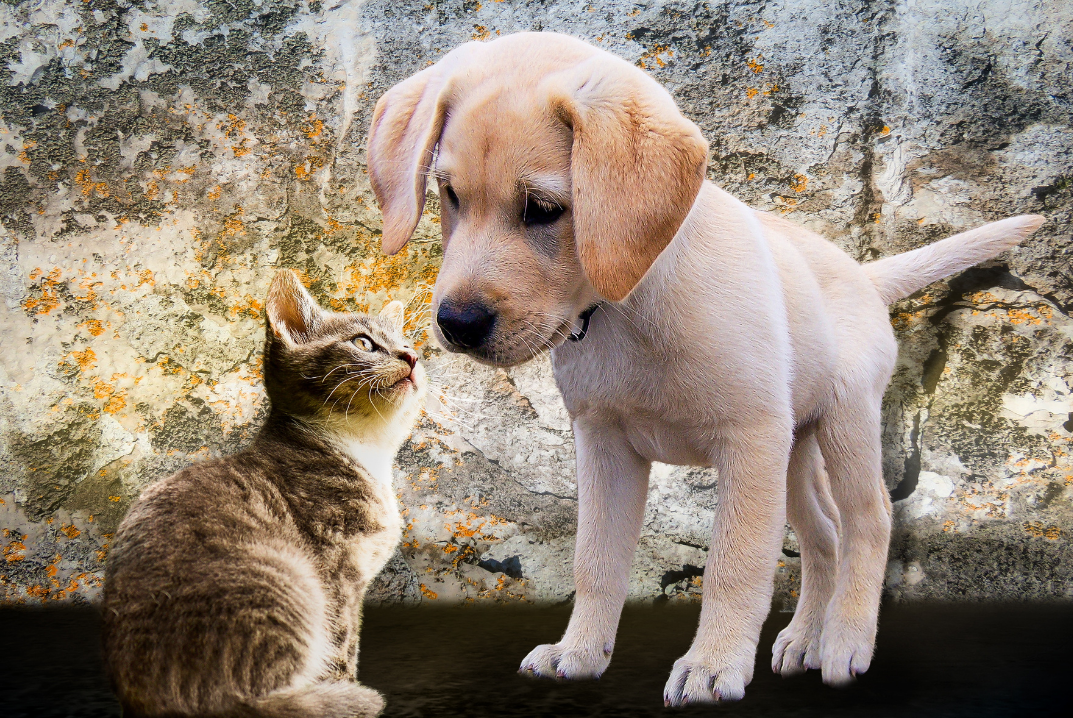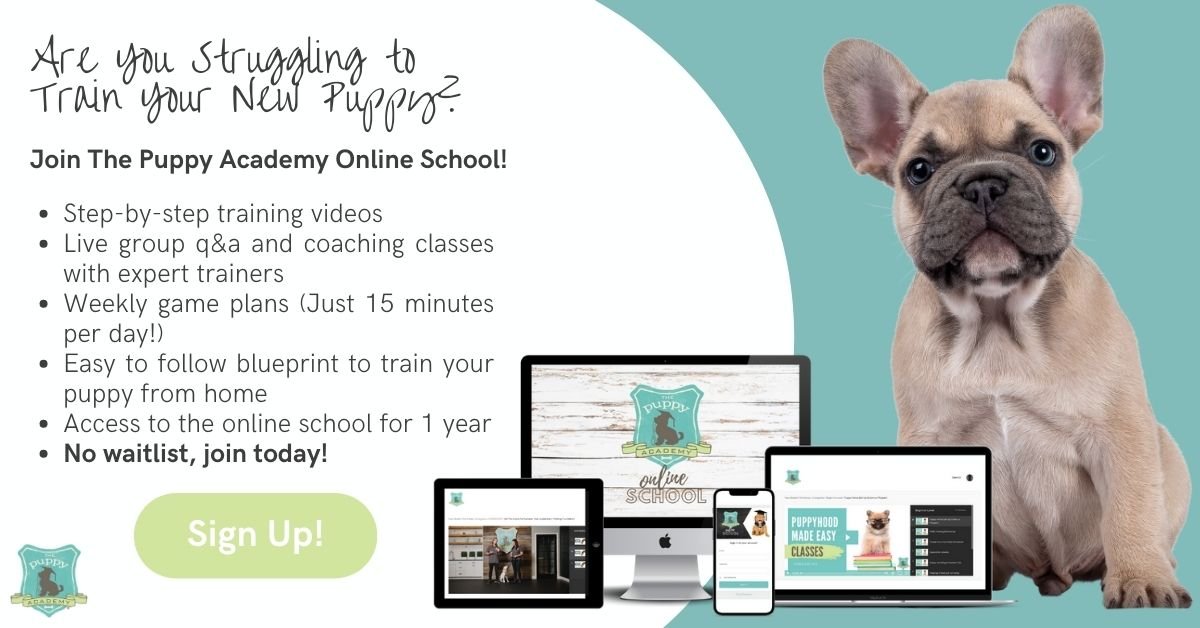Your family is growing by four paws, but what if you already have a cat at home who rules the house?! With the help of this blog, we’ll share tips for how to get your new puppy and current cat off to the best start together!
In a recent blog, we covered steps you can take to introduce your new puppy to your older dog. But what about introducing a puppy to a cat? As both a puppy and cat parent, you’ll want to make those first interactions as positive and stress-free as possible. A few things you’ll need are an understanding of whether your pup and cat personalities are a good fit, reading their body language during the introductions, and step-by-step tips to make those first meetings as smooth and comfortable as possible!
Are your puppy and cat a good match?
Maybe you are still figuring out what puppy to bring home and are trying to find a puppy that would get along with your feline companion. In this case, you can use the factors below to help you make the best decision for your lifestyle and to find the best possible match for your cat!
Puppy breeds: There are plenty of puppy breeds and mixed breeds out there, all with their own sets of personalities, temperaments, energy levels, and drives. Outside of just finding the right breed for you and your cat, it’s always a wise choice to research what breeds fit your lifestyle overall, if they are good with urban vs. suburban living, with children, etc., to make the right choice.
Consider this, there are some high-prey drive breeds that may view a cat or any small animal as natural prey. With these types of breeds, they may not be a great fit for your current living situation and for your cat’s overall well-being.
Also, breeds come in a variety of sizes so if you plan to bring home a large breed, high-energy pup, consider the size difference between your puppy and cat along with their temperament.
If you already have a puppy, however, regardless of their breed regular and consistent puppy training exercises in socialization which we will dive into later in this blog, may help your new pup and cat co-exist peacefully.
Learn Your Puppy and Cat’s Body Language!
Before you introduce your puppy and cat for the first time, there are a few tells in body language to look out for that will let you know if they are each feeling comfortable and relaxed, or showing signs of apprehension.
Puppy body language:
A puppy’s relaxed body language should include things like a soft gaze, steady breathing with an open mouth (not panting), relaxed muscles, and a tail.
As your puppy sees your cat, they may get more aroused with a wagging tail, trying to get closer to them, and looking at them with interest, which can also lead to whining or barking in their eagerness to meet them.
On the other hand, if your puppy starts to lick their lips, yawn, have their hackles raise, bare their teeth, or growl, these are all cues to step in immediately before the situation escalates.
Your puppy may also be unsure or nervous about seeing your cat and run away from them, in which case they shouldn’t be forced to interact. For more puppy body language signs, check out our blog: Know Your Puppy’s Body Language!
Cat body language:
Relaxed body language in your cat will manifest in a steady gaze, pointed ears, tail up and curved at the tip, relaxed whiskers, and overall loose body movements. These are all good indicators that your cat is feeling comfortable around your puppy.
If you notice your cat start to show lip licking, pinned ears, crouching and curved spine, tail low, or hissing, you’ll want to be prepared to step in immediately to create the space between your puppy and your cat that’s needed at the moment. More on this further in the blog!
How to Introduce Your Puppy to Your Cat:
Prepare for a smooth and happy introduction experience by setting everyone up for success. A few things you’ll need are:
A barrier to separate your puppy and cat. This can be a playpen, crate, or baby gate to divide rooms and give them each their own designated space.
Harness and leash for your puppy!
Your treat pouch and a handful of your puppy’s food
With bringing home your new puppy, you likely don’t know how they will be with other animals just yet, and likewise with your cat! You may not know how they do with other dogs or puppies just like! With this in mind, follow these steps for the safest introduction scenario!
Step 1: Put your puppy in their area, and your cat in theirs. This will help both of your pets to feel safe and comfortable in their own space and make the introduction far less stressful.
Step 2: Place the harness and leash on your puppy so you’ll have more control when the two of them meet! (Do this only when you are able to fully monitor your puppy. Don’t leave them unattended with their gear on.)
Step 3: Let your puppy and cat observe each other through their adjoining gate, but maintain the barrier for now. Allow your cat to roam freely around your puppy’s area, coming in closer and moving back as they wish.
Note: For this step, it’s helpful to have someone else help you so both the pup and cat can play or train at the same time. The goal is to have them focus on the positive and fun activity while listening to the sounds of the other one in the next room.
Step 4: When you feel like their interest in each other is growing, the next is to remove the barrier! Let your cat do their own thing again, as you hold on to your pup’s leash with some slack on it. If your puppy walks over to see your cat, move with them to keep the leash loose. (Tension on the leash can entice your pup to pull harder to get to your cat.) We also want to avoid your pup chasing after your cat and then running away!
Pro tip: Have your pup’s treat pouch on you in case your puppy is over-zealous or a bit fearful or nervous so you can gain their attention using their food and redirect them away from your cat when your need to. Try our Name Game beforehand so you and your puppy know what to do!
Step 5: Continue to actively monitor your pup’s and cat’s interactions as they’re becoming comfortable with each other. If you’re ever not able to, have them each in their separate areas so they each feel comfortable whenever you’re not around!
Don’t let your puppy and your cat “Work It Out” themselves!
If animals in the home feel like their humans don’t have any control and don’t advocate for them, you add more stress into their lives. As a result, puppies can grow up to become rougher with the cat, or more fearful. Always guide your puppy and your car to how you want them to behave.
Advocate for Your Puppy and Your Cat
Advocating for your puppy:
If you find your cat is going after your pup, it could create fear in your puppy and they could then become fearful of your cat. Cats often get a power trip over this and will seek out this reaction more and more.
We want to make sure our puppy knows we advocate for them so they trust us to handle the situation and don’t feel the stress of having to stand up to the cat or defend themself on their own.
If you see your cat getting this type of way with your puppy, don’t yell at them. Instead, get between your cat and your puppy, face your cat, and shoo your cat away. Then turn back towards your puppy and work on commands using food work with them to focus on building their confidence! This will teach them to look toward you whenever they’re nervous or fearful.
Advocating for your cat:
Some cats will want to be friendly with your new puppy, but they may not want to necessarily play with them, and it’s important that we respect that! If you notice your cat hissing, whacking, or running away from your puppy, it’s time for you to intervene and advocate for your cat now. We want to avoid them feeling like the new puppy is able to come to intro their home and now do whatever they want.
Intervene immediately when you notice your cat feeling uncomfortable with your puppy through the hissing or whacking. Your cat is not in trouble! They are overwhelmed and advocating for themself in this situation and that means we as the human need to step in to further advocate for them. This will help teach your new puppy boundaries while not making your cat feel overly stressed that they have to do this themself. If they do, that’s when you’ll see cats hiding and never coming back down to ground level. They start to separate themselves from the family just so they can stay clear of the pup.
What if it all works out perfectly and they love each other?!
Amazing! Pat yourself on the back! We’re thrilled your two fur-kids are new BFFs. But, even with this incredible new relationship, we want you to still continue to practice training commands with your pup when they’re around your cat, and especially when they want to play together. Why? Dogs and cats learn from other animals faster than they do people. So when they’re playing with another animal, they can develop the tendency to not list to you at all! By practicing your puppy’s obedience commands with them around your cat, and rewarding them for doing so, you’re building your relationship together, along with their muscle memory, as you create this habit of them listening to you over anything else around them!
This will carry forward to help you when you take your puppy outside and need to reclaim them from a squirrel, another dog, or some other major distraction that has their attention!
Need more help with socializing your puppy with your cat?
Our Online Puppy School has a curriculum full of common puppyhood pains that almost every new puppy owner faces — including how to introduce your puppy to new dogs, cats, people, and situations they will encounter throughout their life!
You’ll be able to watch as our master trainers walk you through real-time puppy socialization demos to better understand a puppy’s body language and signs to look out for when they’re playing, including when you should step in to interrupt if certain behaviors are escalating and how to do it! Plus learn more command training routines we mentioned earlier to work on around your cat at home to ensure your puppy's focus is always on you!
Learn more about The Puppy Academy Online School and how it can help you with your puppy and cat’s introduction and get started today!
Plus, you can watch our weekly Ask a Puppy Trainer Q&A live on @thepuppyacademy Instagram every Wednesday at 1 pm PT to ask them any socialization issues you’re having so they can help coach you through it!
And don’t forget to sign up for our Very Important Puppy mailing list to receive updates, puppy training tips, and more!
Check out these blogs related to puppy training and more!



